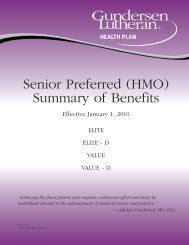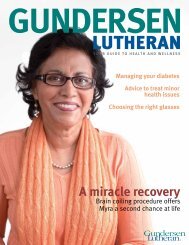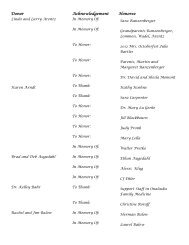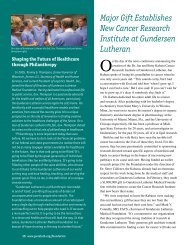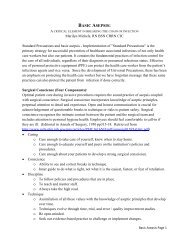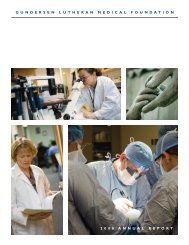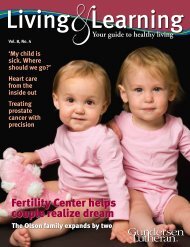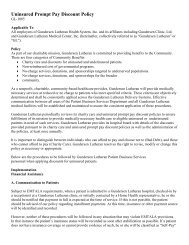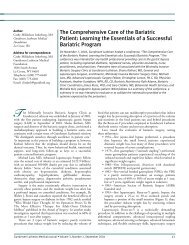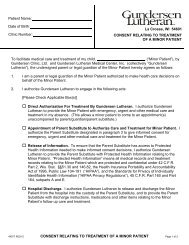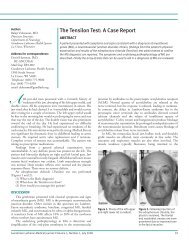ndersen er an - Gundersen Health System
ndersen er an - Gundersen Health System
ndersen er an - Gundersen Health System
You also want an ePaper? Increase the reach of your titles
YUMPU automatically turns print PDFs into web optimized ePapers that Google loves.
Childhood Anorexia<br />
shape conc<strong>er</strong>ns also decreased dramatically. The only aspect that<br />
did not decrease was weight conc<strong>er</strong>ns, which parallels the results of<br />
studies of adolescents receiving similar th<strong>er</strong>apy. 8<br />
More research is needed in ord<strong>er</strong> to find out wheth<strong>er</strong> behavior<br />
<strong>an</strong>d family th<strong>er</strong>apy are effective for children with AN. Children<br />
with AN present diff<strong>er</strong>ently from oth<strong>er</strong> AN patients, so they might<br />
respond to treatment diff<strong>er</strong>ently, as well. For example, because<br />
children tend to rely on their parents more th<strong>an</strong> do adolescents<br />
<strong>an</strong>d adults, family th<strong>er</strong>apy might be more effective in children<br />
th<strong>an</strong> in old<strong>er</strong> AN patients. Addressing family issues <strong>an</strong>d control<br />
may have great implications in the treatment of early-onset of<br />
AN. Anoth<strong>er</strong> consid<strong>er</strong>ation for children with AN is the eventual<br />
onset of adolescence <strong>an</strong>d pub<strong>er</strong>ty, a p<strong>er</strong>iod of tr<strong>an</strong>sition that c<strong>an</strong> be<br />
difficult for AN patients. Even patients who have been treated for<br />
AN <strong>an</strong>d are doing well might benefit from boost<strong>er</strong> sessions during<br />
this p<strong>er</strong>iod.<br />
Outcome<br />
Research on the outcome of individuals with early-onset<br />
AN has shown conflicting results. 9,27 One study used a modified<br />
v<strong>er</strong>sion of the outcome status ratings Morg<strong>an</strong> <strong>an</strong>d Russell used on<br />
adults with AN to examine children with a 2- to 5-year followup.<br />
Outcome was based on the individual’s ratings on 5 diff<strong>er</strong>ent<br />
scales: nutritional status, menstruation, mental state, psychosocial<br />
adjustment, <strong>an</strong>d psychosexual adjustment. 27,28 Ov<strong>er</strong>all outcome<br />
was based on these 5 scales. 27,28 The child study found that 11<br />
(70.6%) of the 17 subjects had <strong>an</strong> ov<strong>er</strong>all “good” outcome. 27<br />
Outcome based solely on mental state or menstruation had the<br />
highest numb<strong>er</strong> of individuals in the “poor” category (n = 4). 27 Poor<br />
ratings in these categories signified a grossly abnormal mental state<br />
<strong>an</strong>d virtually absent menstruation. 27,28 Anoth<strong>er</strong> study also reported<br />
that a small majority of individuals with early-onset AN w<strong>er</strong>e<br />
categorized as having a good outcome (57%). In follow-up 2 of<br />
18 patients reported suicide attempts, which is v<strong>er</strong>y conc<strong>er</strong>ning. 29<br />
Likewise, in a study done by The<strong>an</strong>d<strong>er</strong>, 9 2 individuals in the earlyonset<br />
group had died at follow-up — 1 at 24 years aft<strong>er</strong> onset, <strong>an</strong>d<br />
the oth<strong>er</strong> at 20 years aft<strong>er</strong> onset. In comparison, no individuals in<br />
the late-onset group had died. The patient who died 24 years aft<strong>er</strong><br />
onset had been doing well for 12 years following treatment. 9 Thus,<br />
follow-up studies 2 to 5 years aft<strong>er</strong> treatment may not reflect longt<strong>er</strong>m<br />
outcomes for some patients.<br />
In his 1982 review of the lit<strong>er</strong>ature, Swift concluded that<br />
th<strong>er</strong>e was insufficient evidence to show that the outcome of earlyonset<br />
AN patients was bett<strong>er</strong> or worse th<strong>an</strong> that of late-onset AN<br />
patients. 30 M<strong>an</strong>y studies done to date do not directly compare earlyonset<br />
patient results to those of late-onset patients, thus making<br />
it difficult to directly compare the 2 groups. Howev<strong>er</strong>, based on<br />
his review of the lit<strong>er</strong>ature, Swift concluded that the long-t<strong>er</strong>m<br />
outcome of early-onset patients was equivalent to that of oth<strong>er</strong> AN<br />
patients. 30 In a comparison follow-up of individuals with earlyonset<br />
<strong>an</strong>d late-onset AN, it was found that 45% of individuals<br />
with late-onset AN w<strong>er</strong>e “good” at examination 4 to 10 years lat<strong>er</strong>,<br />
while 2% had died. These results echo the findings of <strong>an</strong>oth<strong>er</strong><br />
follow-up study examining early-onset AN patients. 31<br />
The ass<strong>er</strong>tion that outcomes for early-onset <strong>an</strong>d late-onset AN<br />
patients are similar is not promising. The results are especially<br />
conc<strong>er</strong>ning when one consid<strong>er</strong>s that the long<strong>er</strong> <strong>an</strong> individual has<br />
symptoms of AN, the more difficult it is to int<strong>er</strong>vene. 9 Int<strong>er</strong>vention<br />
occurred at a young age for the subjects examined in these outcome<br />
studies. But if AN symptoms are not recognized <strong>an</strong>d treatment<br />
sought, the course of the disord<strong>er</strong> may be irrev<strong>er</strong>sible <strong>an</strong>d produce<br />
detrimental effects years lat<strong>er</strong>.<br />
Conclusion<br />
Diagnosis is <strong>an</strong> import<strong>an</strong>t issue with AN. More leniency in<br />
the crit<strong>er</strong>ia for diagnosis of early-onset AN may allow int<strong>er</strong>vention<br />
before the disord<strong>er</strong> progresses to a point wh<strong>er</strong>e th<strong>er</strong>e are irrev<strong>er</strong>sible<br />
side effects. In ord<strong>er</strong> to int<strong>er</strong>vene as early <strong>an</strong>d as effectively as<br />
possible, howev<strong>er</strong>, more research is needed on treatment that<br />
targets young<strong>er</strong> individuals with AN.<br />
Although early-onset patients represent a minority of AN<br />
patients, the illness c<strong>an</strong> have s<strong>er</strong>ious <strong>an</strong>d irrev<strong>er</strong>sible health<br />
consequences. 15 Future research should seek to clarify the<br />
diff<strong>er</strong>ences between early-onset <strong>an</strong>d late-onset AN <strong>an</strong>d to identify<br />
the most effective treatments for AN patients of all ages.<br />
REFERENCES<br />
1. Lucas AR, Beard CM, O’Fallon WM, Kurl<strong>an</strong>d LT. 50-year trends in the incidence<br />
of <strong>an</strong>orexia n<strong>er</strong>vosa in Rochest<strong>er</strong>, Minn.: a population-based study. Am J Psychiatry.<br />
1991;148(7):917-922.<br />
2. Lucas AR, Crowson CS, O’Fallon WM, Melton LJ 3rd. The ups <strong>an</strong>d downs of<br />
<strong>an</strong>orexia n<strong>er</strong>vosa. Int J Eat Disord. 1999;26(4):397-405.<br />
3. Bostic JQ, Muriel AC, Hack S, Weinstein S, H<strong>er</strong>zog D. Anorexia n<strong>er</strong>vosa in a<br />
7-year-old girl. J Dev Behav Pediatr. 1997;18(5):331-333.<br />
4. Arnow B, S<strong>an</strong>d<strong>er</strong>s MJ, Stein<strong>er</strong> H. Premenarcheal v<strong>er</strong>sus postmenarcheal <strong>an</strong>orexia<br />
n<strong>er</strong>vosa: a comparative study. Clin Child Psychol Psychiatry. 1999;4(3):403- 414.<br />
5. Nicholls D, Chat<strong>er</strong> R, Lask B. Children into DSM don’t go: a comparison of<br />
classification systems for eating disord<strong>er</strong>s in childhood <strong>an</strong>d early adolescence. Int J<br />
Eat Disord. 2000;28(3):317-324.<br />
6. Matsumoto H, Takei N, Kawai M, et al. Diff<strong>er</strong>ences of symptoms <strong>an</strong>d st<strong>an</strong>dardized<br />
weight index between patients with early-onset <strong>an</strong>d late-onset <strong>an</strong>orexia n<strong>er</strong>vosa.<br />
Acta Psychiatr Sc<strong>an</strong>d. 2001;104(1):66-71.<br />
7. Peebles R, Wilson JL, Lock JD. How do children with eating disord<strong>er</strong>s diff<strong>er</strong><br />
from adolescents with eating disord<strong>er</strong>s at initial evaluation? J Adolesc <strong>Health</strong>.<br />
2006;39(6):800-805.<br />
8. Lock J, le Gr<strong>an</strong>ge D, Forsb<strong>er</strong>g S, Hewell K. Is family th<strong>er</strong>apy useful for treating<br />
children with <strong>an</strong>orexia n<strong>er</strong>vosa? Results of a case s<strong>er</strong>ies. J Am Acad Child Adolesc<br />
Psychiatry. 2006;45(11):1323-1328.<br />
9. The<strong>an</strong>d<strong>er</strong> S. Anorexia n<strong>er</strong>vosa with <strong>an</strong> early onset: selection, gend<strong>er</strong>, outcome, <strong>an</strong>d<br />
results of a long-t<strong>er</strong>m follow-up study. J Youth Adolesc. 1996;25(4):419-429.<br />
10. Am<strong>er</strong>ic<strong>an</strong> Psychiatric Association Task Force on DSM-IV. Diagnostic <strong>an</strong>d<br />
Statistical M<strong>an</strong>ual of Mental Disord<strong>er</strong>s : DSM-IV-TR. 4th rev ed. Washington,<br />
DC: Am<strong>er</strong>ic<strong>an</strong> Psychiatric Association; 2000.<br />
11. Nielsen GB, Lausch B, Thomsen PH. Three cases of sev<strong>er</strong>e early-onset eating<br />
disord<strong>er</strong>: are they cases of <strong>an</strong>orexia n<strong>er</strong>vosa? Psychopathology. 1997;30(1):49-52.<br />
12. Robins PM, Putnam PH. From the children’s corn<strong>er</strong>: a comparison of childhood<br />
vari<strong>an</strong>t disord<strong>er</strong>s of eating <strong>an</strong>d early-onset eating disord<strong>er</strong>s. Eat Disord.<br />
1999;7:149-156.<br />
13. Coop<strong>er</strong> PJ, Watkins B, Bry<strong>an</strong>t-Waugh R, Lask B. The nosological status of early<br />
onset <strong>an</strong>orexia n<strong>er</strong>vosa. Psychol Med. 2002;32(5):873-880.<br />
14. Lask B, Bry<strong>an</strong>t-Waugh R, Wright F, Campbell M, Willoughby K, Wall<strong>er</strong> G.<br />
Family physici<strong>an</strong> consultation patt<strong>er</strong>ns indicate high risk for early-onset <strong>an</strong>orexia<br />
n<strong>er</strong>vosa. Int J Eat Disord. 2005;38(3):269-272.<br />
Gu<strong>nd<strong>er</strong>sen</strong> Luth<strong>er</strong><strong>an</strong> Medical Journal • Volume 5, Numb<strong>er</strong> 1, July 2008 11




